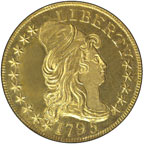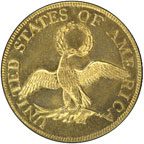
Uncovering America's Heritage... Coin by Coin
1795 Half Eagle
You know how I love gold, so I’m always looking for gold coins to present as Coin of the Month. Well, the half eagle (5-dollar gold coin) of 1795 is a true first with a touch of mystery. What makes it a first is that it’s the very first gold coin of any denomination that the United States Mint ever struck. Its mystery is in its varieties.
Many of the varieties among the early dates came from simple design changes such as stamping one date over another, using different-sized numbers within the dates, and adding a star. Half eagles struck in 1797 can have either 15 or 16 stars on the front. The 16th star was added after Tennessee became the 16th state.
But some varieties are mysterious, unless you know some history. The back of this coin was redesigned in 1798 with a stronger-looking eagle. Since the eagle was changed in 1798, coins made before that year should show the older eagle, right? Yet some of these coins dated 1795 through 1797 use the eagle that hadn’t been designed yet! How can that be?
It appears that the key to this confusion has to do with the yearly epidemics of yellow fever that struck Philadelphia, the city where the United States Mint was located. Every fall, Philadelphians died of yellow fever, though the city was one of the world’s largest at the time. During the 1797 epidemic, the Mint was closed completely.
When the Mint reopened in 1798, new dies for the coin’s reverse had already been created, but some older-dated front dies were still usable. The young United States Mint, needing to save money and catch up with the demand for half eagles, paired those older obverse dies with the new eagle reverses. The coins simply were not made in the years stamped on them.
And here’s a fact that makes this coin not just a “first” but an “only.” Did you know that the United States Mint still makes 5-dollar gold coins? Yes, there are still commemorative and bullion versions of the 5-dollar coin made at the United States Mint at West Point. Even though these coins don’t circulate, they’re the same 5-dollar denomination made in 1795. That makes this denomination the only one that has been struck at every one of the eight branches of the United States Mint—the four that have closed and the four that are at work today.
—Goldie




